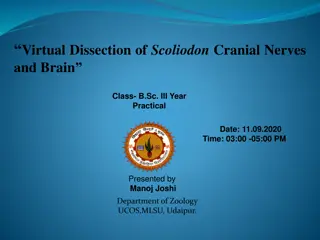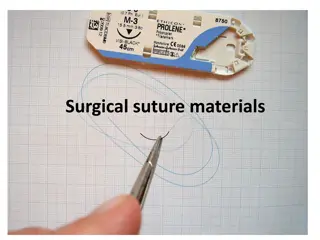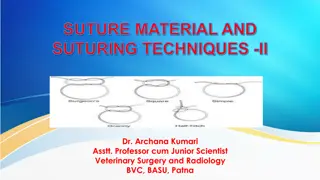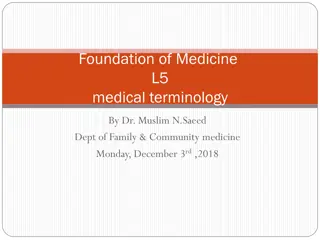Understanding the Brain Stem and its Functions
Explore the intricate structures of the brain stem, including the midbrain, pons, and medulla oblongata. Learn about the functions of the cerebellum, its role in controlling postural reflexes and producing skilled movements. Discover the thick tracts connecting the cerebellum to the brain stem and t
8 views • 20 slides
South East Asia Dental Consumables Market - Opportunity Analysis and Industry
South East Asia Dental Consumables Market by Product [Implants (Titanium, Zirconium), Prosthetics (Bridges, Dentures, Abutments, Veneers, Inlays, Onlays), Endodontics, Orthodontics (Clear Aligners, Brackets), Sutures, Hemostats], End User - Forecast to 2031\n
4 views • 4 slides
Sports Medicine Market to be Worth $10.59 Billion by 2031
Sports Medicine Market Size, Share, Forecast, & Trends Analysis by Product (Arthroscopy, Implants, Prosthetics, Sutures, Braces, Supports, Physiotherapy, Compression), Application (Shoulder, Elbow, Knee, Hip), End User (Hospitals, ASCs) \u2013 Global Forecast to 2031
2 views • 4 slides
Surgical Sutures Market to be Worth $4.42 Billion by 2030
Explore $4.42 billion Surgical Sutures Market: Get exclusive insights on key market trends, segments, geographical analysis, & competitive analysis!\n
1 views • 4 slides
Virtual Dissection of Scoliodon Cranial Nerves and Brain: A Detailed Practical Guide
Explore the virtual dissection of Scoliodon's cranial nerves and brain in this informative practical session for B.Sc. III Year students. Learn about the anatomy and innervations of various nerves like Olfactory, Optic, Trigeminal, Facial, and more. Discover the phylum, group, and class of Scoliodon
0 views • 9 slides
Types of Suturing Techniques and Applications
Explore various types of suturing techniques such as simple interrupted suture, simple continuous suture, subcuticular suture, and Reverdin's continuous sutures. Each technique has its advantages and disadvantages, suited for different applications ranging from skin suturing to suturing blood vessel
1 views • 34 slides
Veterinary Suturing Techniques and Materials Overview
Understanding the principles of suturing in veterinary surgery is crucial for effective wound closure. This article covers different suturing techniques such as apposition, inversion, and miscellaneous sutures, along with details on needle handling, tissue penetration depth, and suture placement. Im
1 views • 14 slides
Understanding Surgical Suture Materials and Techniques
Surgical sutures play a vital role in wound repair by providing support and promoting healing of different tissues. An ideal suture should be easy to handle, minimize tissue reaction, inhibit bacterial growth, and be nonreactive after healing. Suture size, flexibility, and material are key factors t
1 views • 38 slides
Comprehensive Overview of the Nervous System
Explore the anatomy and functions of the nervous system with details on its subdivisions, brain parts, spinal cord features, cranial nerves, and more. Learn about sensory input collection, integration, and motor output functions. Understand the structural and functional organization of the central a
0 views • 23 slides
Mastering Advanced Suturing Techniques for Veterinary Nurses
Explore the nuances of suturing with in-depth topics such as choosing the right suture material, surgical incisions, knot techniques, intradermal patterns, and more. Understand the classification of sutures based on material, structure, and absorbability to enhance your proficiency in suturing proce
1 views • 27 slides
Understanding Ocular Herpes Virus: Pathogenesis, Mechanism of Action, and Clinical Features
Herpes viruses are common human pathogens causing both asymptomatic infection and active disease. Ocular herpes, typically caused by HSV-1, presents with symptoms like pain, photophobia, and blurred vision. Factors like UV rays, trauma, and stress can trigger reactivation. Recurrent infections often
2 views • 33 slides
Exploring Human Origins: Evolution and Phylogenetic Trees
Delve into the fascinating realm of human origins through an examination of humans and African apes, evidence for evolution, and the construction of phylogenetic trees. Understand the relationships between species, common ancestors, and key evolutionary developments that have shaped the course of hu
4 views • 18 slides
Comprehensive Guide to Neurological Examination in Dogs and Cats
Neurological examination in dogs and cats is crucial for diagnosing nervous system disorders. This guide covers the recording of history, general and detailed clinical examinations, examination of CSF, radiographic examination, EEG, and brain biopsy. It includes assessing history, mental state, move
0 views • 20 slides
Understanding Neurological Exams: Assessment and Procedures
A neurological exam evaluates a person's nervous system using various instruments in a healthcare setting. This comprehensive assessment includes evaluating motor and sensory functions, balance, coordination, mental status, reflexes, and cranial nerve functionality. Assessing mental status involves
0 views • 18 slides
Comprehensive CNS Examination Guidelines by Dr. Kiran Nandeshwar
Detailed guidelines for performing a thorough examination of the central nervous system (CNS) covering general examination, higher function assessment, Glasgow Coma Scale, cranial nerves examination, and motor system evaluation. Includes visual aids for each aspect of the examination process.
0 views • 24 slides
Comprehensive Guide to Suture Materials and Techniques
Understanding suture materials and techniques is vital in wound healing. This guide covers the history, properties, and applications of sutures, as well as contraindications and timelines for different tissue types. It explains the use of suture needles, needle holders, and different types of suture
3 views • 45 slides
Divergent Evolution of Nanotyrannus lancensis and Tyrannosaurus rex in the Hell Creek Formation
This content discusses the hypothetical divergent evolution of two apex predators, Nanotyrannus lancensis and Tyrannosaurus rex, from the Hell Creek Formation. It includes insights on their cranial osteology, tooth count, brain characteristics, and ontogeny, shedding light on their evolutionary path
0 views • 22 slides
Understanding Craniosynostosis: Premature Fusion of Cranial Sutures
Craniosynostosis is a pathological condition resulting from premature fusion of cranial sutures, leading to deformities in the cranial vault and base. It affects skull growth and brain development, with closure of sutures and fontanelles occurring by adulthood. Historical insights by Otto and Vircho
0 views • 74 slides
Comprehensive Adult and Pediatric HEENT, Neck, and Cranial Nerves Examination Guide
This comprehensive guide outlines the components of a normal HEENT, neck, and cranial nerves examination for adults and pediatric patients, including identifying abnormal findings and conducting focused exams. It covers common or concerning symptoms related to the head, eyes, ears, nose, oropharynx,
0 views • 77 slides
Understanding Myasthenia Gravis: Symptoms, Diagnosis, and Management
Myasthenia Gravis (MG) is a neuromuscular disorder characterized by muscle weakness and fatigability due to a decrease in acetylcholine receptors at neuromuscular junctions. It primarily affects individuals in two age peaks, with different symptoms and gender predominance. The cardinal feature is we
0 views • 25 slides
Neurological Complications of Lyme Disease: Symptoms and Markers
In patients with Lyme disease, various neurological complications can arise, including inflammation of brain tissues, cranial nerves, and membranes around the brain. Symptoms range from headaches and neck stiffness to cognitive changes, mood swings, and sensory numbness. Specific markers, such as el
0 views • 24 slides
Exploring the Olfactory Nerve and Its Role in the Sense of Smell
The olfactory nerve, the first cranial nerve, plays a crucial role in our sense of smell. It is unique for its ability to regenerate, with basal cells facilitating this process. The olfactory system is responsible for detecting odors and is essential for various behaviors in mammals. This system con
0 views • 20 slides
Understanding Surgical Suture Materials and Techniques
Surgical sutures play a crucial role in wound repair by providing support for healing tissues. An ideal suture should match tissue strength, be easy to handle, inhibit bacterial growth, and more. Suture size, flexibility, and material selection are key considerations for successful outcomes in vario
0 views • 33 slides
Suture Materials and Techniques in Veterinary Surgery: Insights and Guidelines
In this comprehensive guide by Dr. Archana Kumari, explore the goals, characteristics, and armamentarium of suturing, along with suture materials, principles, techniques, and surgical knot considerations. Discover the objectives and qualities of an ideal suture material, as well as the physical stru
0 views • 13 slides
Understanding Surgical Suture Materials and Techniques
Surgical sutures play a crucial role in wound repair by providing support and hemostasis to healing tissue. An ideal suture should meet specific criteria for handling, reaction in tissue, bacterial growth inhibition, knot security, and more. Factors like suture size, flexibility, and surface charact
0 views • 24 slides
Auditory Pathway in the Brain: Nuclei, Pathways, and Connections
Explore the anatomy of the 8th cranial nerves, specifically the auditory pathway in the brain. Learn about the nuclei related to vestibular and cochlear nerves, their types and locations, along with descriptions of the vestibular and auditory pathways. Discover the primary auditory cortex, medial ge
0 views • 23 slides
Understanding the Anatomy of the Fetal Skull
The fetal skull is a bony cavity that protects the delicate brain and plays a crucial role in the birthing process. This detailed guide explores the composition of the fetal skull, including the bones, sutures, fontanels, regions, and landmarks. Understanding these aspects is essential for assessing
0 views • 18 slides
OSCE Suggested Answers May 2016
This presentation covers a series of OSCE case scenarios along with suggested answers. Topics include abdominal aortic aneurysm, purple urine bag syndrome, cystic lesions in the cranial fossa, opioid and anticholinergic overdoses, lung collapse, and more. Detailed solutions and management plans are
0 views • 11 slides
Innovative Healthcare Solutions Evaluation
This evaluation assesses the effectiveness of different healthcare aims: screening and managing visual impairments in stroke patients, enhancing communication between healthcare and social care services through software, and implementing AI for faster detection of cranial hemorrhage. The aims focus
0 views • 4 slides
Understanding Facial Nerve Disorders: An Overview
Facial nerve disorders can lead to various symptoms such as facial paralysis and otalgia. This article covers the embryology, anatomy, and neuropathophysiology of the facial nerve. The development of the facial nerve complex occurs in the early stages of gestation, and abnormalities may be associate
0 views • 39 slides
Ocular Presentation in Diseases of Central Nervous System - MBBS Lecture
Ophthalmologist Dr. Sanjeev Kumar Mittal from AIIMS Rishikesh discusses the ocular manifestations of intracranial lesions, emphasizing the importance of early diagnosis by ophthalmologists. Symptoms include headaches, vision changes, seizures, and more, while signs may include visual field defects,
0 views • 32 slides
The Anatomy of an Insect Head: A Detailed Look
Explore the intricate structures of an insect head, including the segmentation, sclerites, sutures, and specialized features like the occiput and ocular sclerites. Discover the unique characteristics that define the head capsule in insects through frontal, lateral, dorsal, and posterior views, shedd
0 views • 10 slides
Differential Diagnosis of Infant with Sudden Onset Weakness and Neurological Symptoms
A 2-month-old infant presented with sudden onset weakness in all four limbs following an upper respiratory tract infection. Clinical findings include froglike posture, diminished tone in all limbs, absent reflexes, and cranial nerve involvement. Possibilities include brainstem encephalitis, myelitis
0 views • 29 slides
Surgical Approaches to Foramen Magnum Lesions: Anatomy and Considerations
Surgical approaches to foramen magnum lesions involve understanding the anatomical structures, diameters, condyles, and contents of the region. Critical considerations include the choice of surgical approach based on the location and extent of the lesion, size, and nature of the pathology. Approache
0 views • 53 slides
Comprehensive Guide to Neurological Exams
This guide provides a detailed overview of neurological exams, focusing on components such as cognition, motor function, and cranial nerves. It covers essential aspects like mental status, reflexes, sensation, and gait assessment. The importance of thorough examination in primary care settings is em
0 views • 29 slides
Major Body Systems and Cavities in Human Anatomy
Understanding the major body systems, including skeletal, muscular, cardiovascular, lymphatic, immune, respiratory, digestive, urinary, nervous, endocrine, reproductive, integumentary, and special senses systems, as well as the dorsal cavity comprised of the cranial and spinal cavities. Each system
0 views • 20 slides
Anatomical Terminology Practice Exam: Body Regions and Landmarks
Test your knowledge of anatomical terminology by identifying various body regions and landmarks in this interactive practice exam. Practice naming cranial, cervical, thoracic, pubic, pectoral, axillary, brachial, and antecubital regions with the help of visual aids. Improve your understanding of ana
0 views • 32 slides




































